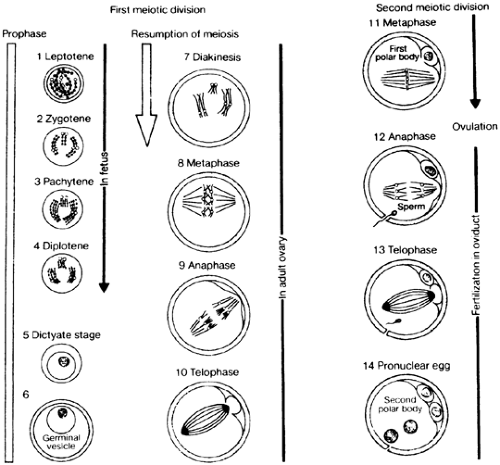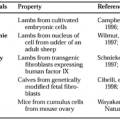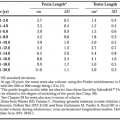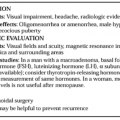OOCYTE MATURATION
Oocyte maturation in mammals proceeds from the development of a differentiated gonadal ridge in the fetus. For example, at approximately day 11 in the female mouse, primordial germ cells have located within the genital ridge, and ovarian development ensues.5 In humans, primordial germ cells arise in the yolk sac in the fourth week of fetal life and begin migration caudally toward the genital ridge during the fifth week. The first meiotic division occurs in the fetal ovary, and the oocyte becomes arrested at the diplotene stage. A germinal vesicle (nucleus) then forms. The first meiotic division is completed in the adult ovary, and the onset of this process is heralded by germinal vesicle breakdown. After telophase I, the first polar body of the oocyte is formed.
The second meiotic division begins before ovulation, and the mature oocyte is fertilizable at the anaphase II stage. Fertilization occurs during anaphase II, and the completion of telophase II finds the zygote with two polar bodies and two pronuclei (Fig. 107-1). The oocyte and follicular maturation are discussed in Chapter 94.
 FIGURE 107-1. Diagram of oocyte maturation. Completion of the prophase of first meiotic division occurs in the fetal ovary of most animals. At zygotene (stage 2), homologous maternal and paternal chromosomes commence pairing; at pachytene (stage 3), pairing has occurred throughout their lengths, and they form bivalents. Each homologue separates longitudinally to create two sister chromatids; thus, each bivalent forms a tetrad. It is during this stage that crossing over occurs, causing an interchange of genetic material between the paternal and maternal chromatids. At the diplotene stage (stage 4), the chromosomes commence their separation; they remain connected at their points of interchange (chiasmata). The germinal vesicle appears after the first meiotic arrest after the diplotene stage. The dictyate stage is a quiescent period, which may last for many years. In the adult ovary, the first meiotic division is completed. Ovulation occurs after extrusion of the first polar body (stage 11), and the second meiotic division (stages 12–14) is completed after sperm penetration. The zona pellucida is shown as a stippled ring (see Chap. 87). (From Tsafiri A. Oocyte maturation in mammals. In: Jones RE, ed. The vertebrate ovary. New York: Plenum Publishing, 1978:410.)
Stay updated, free articles. Join our Telegram channel
Full access? Get Clinical Tree
 Get Clinical Tree app for offline access
Get Clinical Tree app for offline access

|



